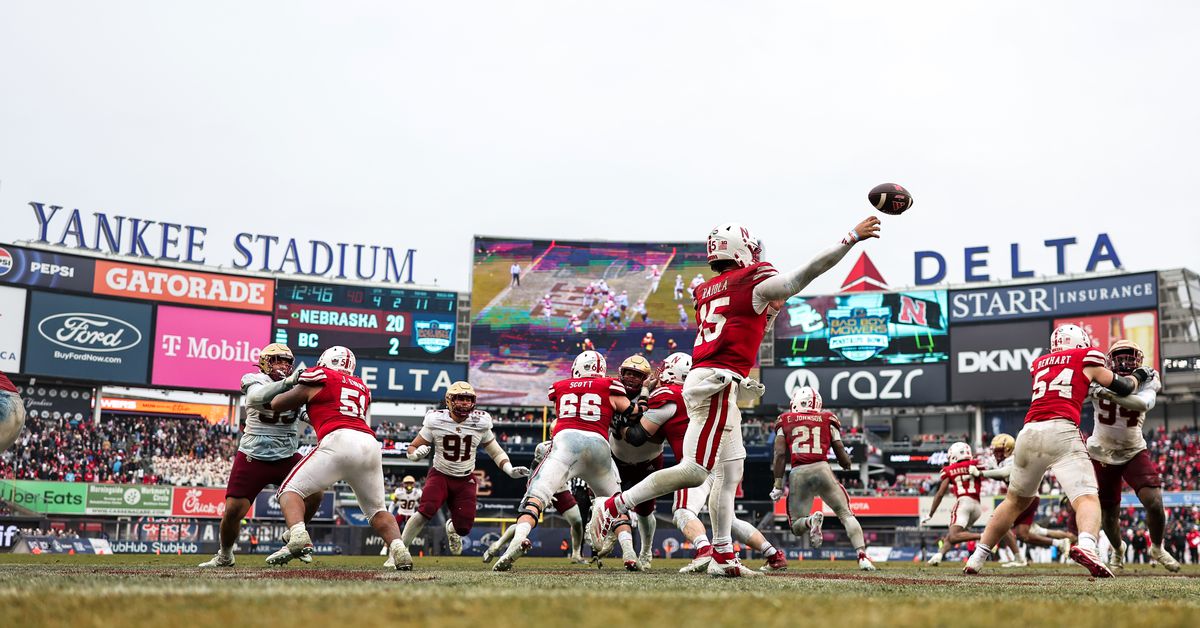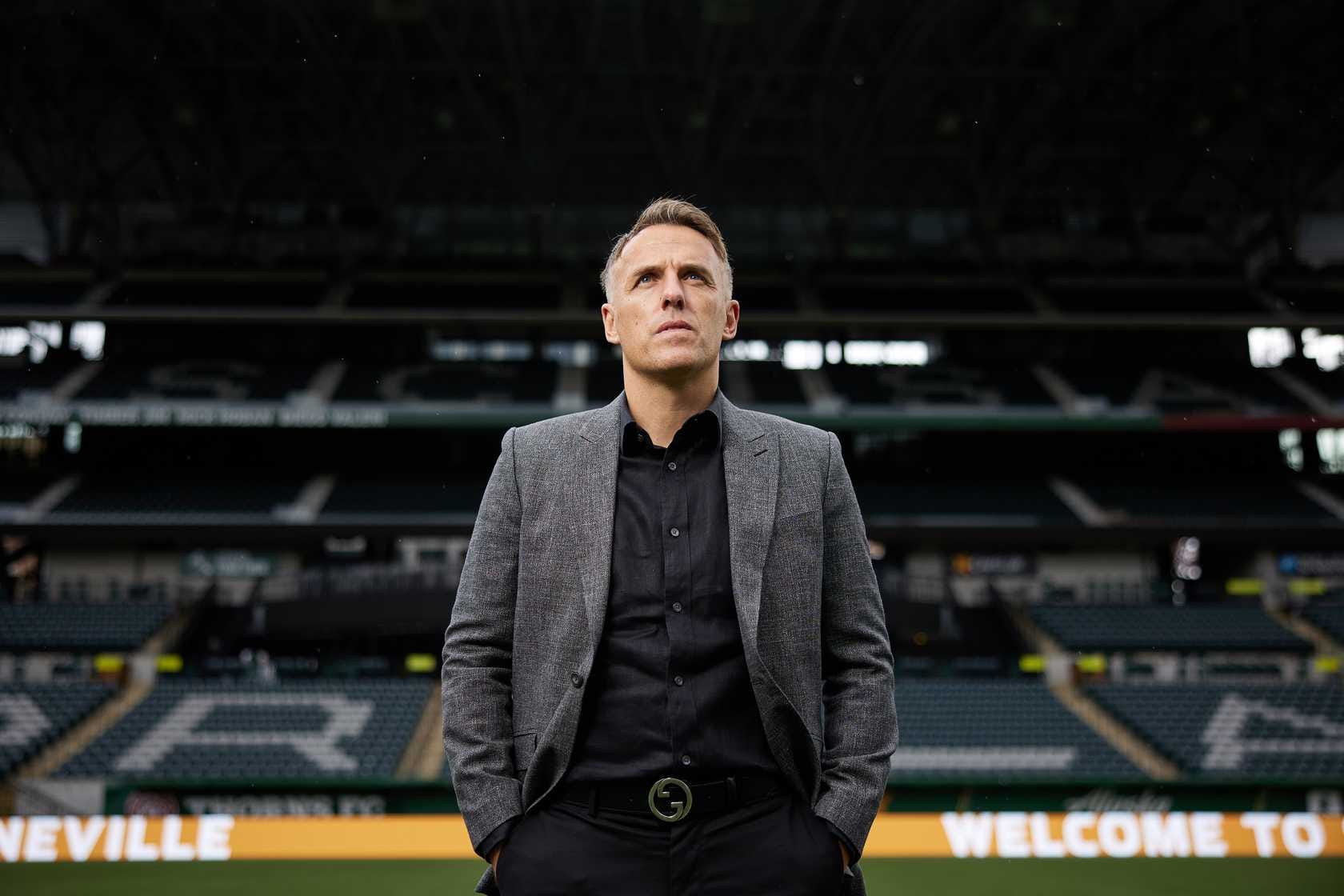Duck Dive: Nebraska Cornhuskers Football 2025 Preview
Special thanks to TJ Birkel of The Common Fan for joining me to discuss Nebraska’s roster on this week’s podcast:
:no_upscale()/cdn.vox-cdn.com/uploads/chorus_asset/file/26031832/Nebraska_offense.png)
Nebraska’s offense, not just on the scoreboard but in each of the metrics of fundamental strength I track from charting, has significantly underperformed their talent ratings all four years I’ve been watching this team. That includes former head coach Scott Frost’s last full year in 2021, the first few games in 2022 before he was fired and the interim coach Mickey Joseph finished the season, current coach Rhule’s first year with offensive coordinator Satterfield in 2023, then Satterfield calling plays for the first eight FBS games in 2024 followed by his demotion to TE coach and the promotion of current OC Holgorsen to playcaller for the final four games. Much of the growth in the 2024 stats was long overdue and probably better understood as a return to baseline for where the Cornhuskers should be given their talent level, but certain obstacles had been blocking that return in recent seasons – the chaos of the staff turnover, a bizarre long-running ball security problem, and both severe running back injury and quarterback ineffectiveness issues in 2023.
On last year’s podcast, TJ and I discussed dissatisfaction with Satterfield’s playcalling and Rhule’s loyalty to him, but the fact that there were so many inherited difficulties with the program and then additional personnel problems complicated evaluating him. With a new 5-star QB getting ready to take over as well as a better looking running back room (and this was unknown at the time, but the teamwide butterfingers thing would ease up too), 2024 looked like a chance for fresh eyes on the matter. After what seemed like a good start to the season, a string of losses threatened to keep Nebraska from a bowl game yet again and Rhule made the coordinator change during the bye week.
TJ and I resumed our discussion this Summer with the effects that switching quarterbacks, running backs, and playcallers had on the offense, attempting to tease apart which things were responsible for growth, which things were inevitable, and what trends were likely to continue into 2025 vs which were just temporary for finishing out the season. Though I’m sure it hasn’t always been fun for Huskers fans, the last several years have provided quite a robust dataset with plenty of natural experiments for determining what has and has not been effective in Lincoln, which includes a few things which may be surprising on diving deeper into the data and sets up several fascinating questions for 2025.
Holgorsen will continue as offensive coordinator in 2025, the quarterback returns for his true sophomore season, and the Huskers return one of their most effective rushers of the last couple of years, so it was natural to try and make some projections about the trajectory of the offense from the last four games. Here’s the breakdown in stats for offensive performance in the the FBS games Satterfield called vs the ones Holgorsen called:
:no_upscale()/cdn.vox-cdn.com/uploads/chorus_asset/file/26031831/Nebraska_off_by_OC.png)
The first thing that should be noted is the tremendous growth in rushing performance was happening from the beginning of the season, and in my opinion was about two years overdue – the offensive line run blocking was good enough by mid-2022 for those kinds of efficiencies, but they underperformed that year due to coaching problems and in 2023 due to running back injuries discussed in last year’s article. But I think Holgorsen should be given full credit for making improvements on top of that … the five percentage point growth in rushing efficiency and attendant improvements in rushing average and explosiveness match up with TJ’s comments about narrowing the focus here onto the most effective playcalls that I observed on film and cutting out extraneous ones, there was some good self-scouting over the bye week.
The passing numbers are interesting. In terms of personnel performance, the young starter #5 QB Raiola was very steady, with effectively identical NCAA passer ratings from the beginning of the year to the end and across both coordinators at about 128, adjusting for garbage time, which is a bit less than a standard deviation lower than FBS median – not unexpected for a true freshman, but still a big improvement from the catastrophe of the 2023 season. But there is a change in the profile of the passing playcalls between coordinators, with Satterfield showing less efficiency and more explosiveness and Holgorsen the other way around. In my opinion this was deliberate – given that the rushing offense was efficient but not explosive in his tenure, Satterfield seemed to think the only way they were really moving the ball was big passing plays, and then Holgorsen boosted the run game and used it to play for more confidence-building short throws with his young QB.
TJ gave what seemed like a partial endorsement to this theory, saying that there’s probably something to the efficiency plan but game circumstances when going up against Iowa and the weirdness of the bowl game probably factored more into it, while pointing to lighting up Wisconsin (a long-awaited release) as the explosive gameplan that Huskers fans would have expected more of had Holgorsen taken over earlier. At any rate, for 2025 Raiola will no longer be a freshman and they’ll have had plenty of time to work together, so I think TJ’s right to predict the full playbook will be open in the coming season. If there’s a bottleneck to explosive passing, I think it’ll come from something besides the QB or playcalling.
My expectation due to historical data trends for young QBs with his level of experience — though that’s not a guarantee — is that Raiola will get his passer rating up to at least FBS median as a sophomore, and whatever additional growth he gets is anybody’s guess and likely more informed by surrounding pieces. For the rest of the room, Raiola’s classmate Daniel Kaelin transferred out — this seems straightforward enough, after Raiola proved he wasn’t a bust Kaelin’s path to playing time in Lincoln was minimal since they’re too close in age — while the NAIA grad transfer #19 QB Gramstad remains. TJ thinks he’s the backup if there’s an issue with Raiola … I’ve never seen him throw but he’s been around the block and there’s evidently some good rapport. A couple freshmen QBs have also been added to the room with timelines more conducive to playing time after Raiola finishes, prep recruit #14 QB Lateef and #16 QB Davila who redshirted last year at Purdue.
Despite the remarkable growth in the rushing performance through the end of the 2024 season and its recovery from some very unfortunate injury issues, the way the running back room has been managed during coach Rhule’s tenure has left me puzzled in a few ways. In last year’s article I’d broken down the numbers after the very effective backs Gabe Ervin and Rahmir Johnson got hurt – they gave the ball a little less than 40% of the time to a young #21 RB E. Johnson, a good choice but not often enough, though far more to a very unproductive senior back with one of the lowest per-carry success rates I’ve ever seen, and since the three other RBs (plus three QBs!) all out-performed him with the same o-line and playcalls it’s simple to trace the issue in 2023’s run game to him and by extension the staff’s failure to re-examine the distribution.
Next, while efficiency soared in 2024 just from that senior graduating, it was baffling why they didn’t give the ball to Ervin at all — TJ told me he wasn’t hurt, he just got lost in the shuffle — instead crowding a room of three healthy, productive backs with a fourth in Oregon transfer Dante Dowdell and giving him the plurality of meaningful carries. Dowdell’s efficiency numbers were excellent as he’s built to be a short-yardage back, over 60.5% success rate, but at just under 4.0 adjusted YPC and very poor 8.2% explosiveness he would just barely get it over the line – every other back outgained him on a per-carry basis.
For 2025, Rahmir Johnson graduated (his per-carry numbers for years have been the best on the team but I think his injury history and miles on the tire kept NFL interest away, sadly), and both Dowdell and Ervin transferred out. In my opinion Dowdell was maxed out and this wasn’t a major loss had they kept Ervin, but losing them both to the portal seems suboptimal.
The other Johnson (no relation) returns and will no doubt be the lead back, and I think his numbers look good and are poised for even more growth under Holgorsen. But it’s an open question who the second and third backs are, and whether the staff is content with the returners or if they struck out with their portal attempts (TJ mentioned them trying to get a Nebraska native who’d gone to North Dakota State and I watched demolish Montana State in the FCS finals). As it is, they return two mid 3-stars without meaningful playing time, #28 RB Ives from the 2023 cycle and #35 RB M. Nelson from 2024, and have added two high 3-star preps this cycle in #23 RB Booth and #24 RB Parker. TJ said the staff is high on Ives and he’s the oldest in the room so I’ll go with him, but that’s really just a guess and it’s hard to say if last year’s gains are going to be sustained with this much unknown about the room.
The tight end unit loses the frequently targeted Thomas Fidone (who was, as TEs with good hands often are, the young QB’s favorite outlet in a tight spot), drafted in the 7th round by the Giants, and the former walk-on Nate Boerkircher who mostly served as a blocker and transferred to Texas A&M.
Nebraska hasn’t added anyone to the roster here, no prep recruits or portal additions. Instead they’ve been bringing along three young tight ends plus a former walk-on, and have converted the backup QB from the last couple of years into this room. TJ thinks that the oldest two of the group, the convert #10 TE Haarberg and the walk-on #44 TE Lindenmeyer will get the playing time here, while the young players continue to develop. Those three are high 4-star #29 TE C. Nelson and mid 3-star #82 TE Ingwerson from 2024 and low 4-star #87 TE Markway who started out at LSU in 2023 but has been in Lincoln since last year.
None of these five have any meaningful experience as fulltime tight ends, though Lindenmeyer saw garbage time reps and Haarberg has been on the field a lot as a QB and later for some gadget plays. It’s tough to predict how this is going to shake out – continuing to develop young bodies in such a demanding position as TE isn’t necessarily a bad sign but this is hardly the conventional pipeline. Just about anything is a reasonable possibility for the outcomes of this unit given how unknown everyone is.
The wide receiver unit was pretty absurdly overstuffed last year with 14 scholarship wideouts (I think, the count gets a little dodgy). For all that, 85% of meaningful targets were given in a fairly even distribution to the top trio, all of whom were new additions that year: then-true freshman #17 WR Barney, and transfers Jahmal Banks from Wake Forest and Isaiah Neyor from Texas. Banks was very effective in his per-target numbers, championship caliber efficiency and yardage, while the other two were well below average at about 45.5% success, with mediocre 6.8 YPT for Neyor and a very poor 5.5 YPT for Barney. Banks and Neyor both signed UDFAs, with the Ravens and 49ers respectively, while Barney returns.
A distant fourth place was Jaylen Lloyd, whose per-target success rate was abysmal at under 40%, and he’s transferred to Oklahoma State. Five more wideouts also transferred out while getting no meaningful playing time. Two didn’t puzzle me, Alex Bullock and Isaiah Garcia-Castaneda, but losing the physically promising and apparently healthy Malachi Coleman to Minnesota plus two bluechip freshmen who didn’t play and transferred to an FCS and a Div-II school, all locals to Nebraska, makes me think something is very odd about talent evaluation in the Cornhusker state.
There are five other returners besides Barney, though they haven’t gotten much playing time. The guy I’ve seen the most often of them is #16 WR Bonner, who oddly got classified as a fullback when he first came in and sometimes lines up as an H-back – he got 11 targets outside of garbage time last year, including one touchdown, and TJ thinks he’ll be part of the two-deep in some way, but I don’t have enough data to make a guess on how much or how effectively. The two 2023 high 3-stars we haven’t seen in two years, #11 WR D. Bell because he redshirted then hurt his knee in the 2024 Spring game and missed the season but was getting a lot of hype beforehand, and #12 WR Doss who was converted from a defensive back. The mid 3-star 2024 recruits redshirted last year and TJ hasn’t heard much about either of them, those are #89 WR Q. Clark and #85 WR K. Smith; they have the lowest talent ratings of the unknowns but they’re also the biggest guys in the room.
There are six additions. Two are transfers and highly experienced with a lot of productivity under their belts, #13 WR Hunter from Cal and #18 WR Key from Kentucky (who comes over with WR coach Shorts after the previous WR coach left to join up with his father at Texas Tech). The four true freshmen are mid 4-star #86 WR Mills, low 4-star #84 WR Mozee, mid 3-star #88 WR Carpenter, and low 4-star Jeremiah Jones who’s a Fall arrival. TJ said he knows the least about Carpenter and Jones at 6’4” is physically gifted but will probably redshirt, though Mills and Mozee will in all likelihood get early significant playing time.
Evidently the staff is all-in on Barney, and TJ said the fanbase is excited about his athleticism and toughness. I thought that was surprising because his numbers were pretty far from the true freshman heroics of some others in the Big Ten, but I’m also not willing to write off a freshman either and it’ll be interesting to see where his career goes. Hunter and Key are known quantities on the outside, there are no doubts who the starters are there and that the production should be reliable and high quality. The question for the passing game is whether defenses will be able to get away with locking onto Hunter and Key because the tight end unit is a big question mark and there’s no other commensurate threat in the wide receiver room. As we discussed on the podcast, it’s entirely possible, maybe even likely that the fourth, third, or even second leading wideout by the end of the year is a true freshman – such a thing was already true for Nebraska in 2024.
There were two changes in the offensive line unit during 2024, one caused by injury and which creates a surprise for the 2025 season, while the other was entirely predictable to longtime readers. Even in those positions, the changes happened relatively early and the Huskers got stable — and as it happens, superior — play out of the replacement for the rest of the year, and in the other three positions the starter got uninterrupted meaningful reps all season.
At center and right tackle, multi-year starters Ben Scott and Bryce Benhart played all year and have graduated; Scott signed a UDFA with the Buccaneers. Benhart was highly rated out of high school but never graded out as an effective blocker (TJ brought up a close loss which can be tied to a missed block of his; he’s right of course and several other games could have been named but this is the nature of close losses, any one play going another way changes the outcome, and Nebraska has a surfeit of them to choose from); across both staffs neither had the stomach to replace him. At left guard as expected they went with #51 LG Evans, who was the backup in 2023 and has some experience at center; TJ said he thinks Evans will slide over to center in 2025.
For right guard Nebraska brought in a Florida transfer who had originally signed with Rhule back at Baylor in 2020, Micah Mazzccua. On last year’s podcast, TJ and I figured the temptation would be too great to start the transfer they specifically brought in for the job and indeed that’s what they did, even though they had an experienced homegrown backup in #59 RG Lutovsky. After two games Mazzccua was demoted to backup and Lutovsky had the starting job for the rest of the season in yet another demonstration of the transfer portal effect for offensive linemen. Mazzccua has graduated while Lutovsky returns and will likely be a starter at one of the guard spots.
The starter at left tackle since 2021 has been former bluechip #69 LT Corcoran. He’s dealt with several injury issues during his career and has at times switched over and played guard. Like Benhart on the right (who had started since 2020), the grades on my tally sheet for Corcoran have been very poor in pass protection for his entire career, and last Summer TJ and I discussed the possibility of sliding him back inside to guard and having a different player, perhaps #65 OL Prochazka or Georgia transfer Jacob Hood or Utah transfer #75 OL Knaak (in order of preference), take over. But Prochazka was injured in Fall camp, Hood never played and transferred back out, and Knaak is evidently still not a serious option. Corcoran got the start again, but after getting beat badly yet again in the redzone and costing Nebraska a 1st quarter touchdown in their week 4 loss to Illinois, he was replaced by redshirt freshman #77 OL Gottula. While not perfect, the backup’s grades were an improvement and he played for the rest of the year. Evidently on that play, Corcoran suffered a “significant” hamstring injury that required him to miss the rest of the season, and allowed him to take a redshirt. So unexpectedly, he’s returning for another year in 2025.
Nebraska has taken two transfers, both high 4-stars out of high school: #50 OL Spindler, a guard for Notre Dame who didn’t win the job out of camp the last two seasons but still wound up with lots of starting time both years due to injuries, and #57 OL Pritchett who was Alabama’s starting right tackle last year. I’ve happened to chart both for different projects and think that Spindler is the real deal while I have some significant issues on my tally sheet with Pritchett (Alabama’s entire offensive line has had some very weird developmental problems for the last several seasons, going back to the final couple years of Nick Saban’s tenure).
Figuring out the interior of the line isn’t difficult: Evans at center, Lutovsky and Spindler at guards. Taking a single transfer lineman is manageable and of the two, Spindler is the one to play. Tackle has five options: Corcoran the surprise returner, Gottula the competent homegrown backup, Prochazka the veteran but with his own injury issues, Knaak the Utah transfer I’ve never thought highly of but has been in Lincoln for a couple years now, and Pritchett the new Alabama transfer. My order of preference would be Gottula first, then Prochazka, Knaak, Corcoran, and Pritchett last. TJ told me that Pritchett probably has the RT job locked down because he was brought in for that purpose, and the competition is just on the left side. He’s probably right, even though I think that’s a mistake on the staff’s part, because of the Mazzccua precedent … though by the same history perhaps they’ll make an early change.
TJ and I also discussed the development vs management aspects of OL coaching, and how interesting it was that the youngest tackle in Gottula — and only non-Frost recruit — was the one who garnered the least amount of concern last year. I think it’s an ongoing indicator that OL coach Raiola, uncle to the QB who took over in 2023 and survived the transition, has been recruiting this unit so hard, with 13 preps over the last three cycles averaging close to a borderline 4-star talent rating in the 24/7 composite – they need to get the new guys ready and switch over to them because they’ve just got more in their tanks than the holdovers, and this is the last of the tricky management years before that happens (this was a running theme for many of the units we discussed really, but it’s clearest in the offensive line where development is so painstaking and turnover takes much longer). I think the choices that the tackle positions present will be a prime test of those management abilities.
:no_upscale()/cdn.vox-cdn.com/uploads/chorus_asset/file/26031829/Nebraska_defense.png)
In F+ advanced statistics, the 2021-23 three-year average for the seven Big Ten West was to have an 80th ranked offense and a 28th ranked defense – as we’ve called it on the podcast, “The Bubble”. In raw stats, which don’t perform opponent adjustments or control for garbage time or several other forms of data pollution, the discrepancy is even wider. It presents a chicken-or-the-egg riddle for any observer: are these defenses actually that good, or are they just benefiting from playing bad offenses? In 2024, the bubble burst as divisions were eliminated and former West teams would be exposed to more diverse and better offenses from former East division and Pac-12 schools, and we’d get to see.
My predictive model from charting those three years had finer-grained data controls than other advanced statistical models (a theoretical discussion of why charting-informed models outperform entirely algorithmic ones would be lengthy and exceed the scope of this article but it has to do with more precise tailoring of non-representative play elimination and incorporating player grades as well as the cause(s) of play and/or drive success/failure, which can only be done through time-intensive film review), and so last offseason I set out a challenge for myself as a film reviewer to beat the algorithms and project which former West division defenses would come through unscathed because they were for real, and which would collapse because they weren’t.
My picks were that Iowa, Minnesota, Nebraska, and Northwestern were the real McCoy, while Illinois, Purdue, and Wisconsin were smoke and mirrors. I did pretty well – Iowa was a top 10 defense yet again, Minnesota rebounded from an off year in 2023 to jump to 12th in 2024, Wisconsin and Purdue’s collapses need no elaboration, Illinois had a nice season in the win column but their defense came in at 44th which was way off their previous 3-year average of 29th , and Northwestern … was complicated but it was the offensive tempo change that made them look bad I promise.
For Nebraska, I think I got it sort of right, and as I talked about with TJ, I wish I’d used a third category for “half-step back” because he was correct on the podcast, there’s kind of a mixture of both things going on for the Huskers defense – it was pretty good, as he called it, complaints about the 2024 performance are awfully nitpicky, but there are modest, measurable declines in all six metrics from charting, and it’s very difficult to disentangle the burst bubble effect, a particular cornerback change, and defensive front fatigue. If there’s a question about whether Nebraska’s 8th place ranking in F+ for 2023 — under former DC Tony White in Rhule’s first year — was totally legit since they went to 14th for 2024 facing a different schedule, I think the best answer is that it mostly was, but with a hint of smoke.
As TJ has mentioned several times, White flipped the defense immediately on arriving in 2023. It had been fading hard in 2021 under Frost — there’s a big differential that year between my model, which would have ranked the Huskers defense in the mid 50s, and F+ which ranked them 22nd — and then fully fell apart in the interim season. White brought over an interesting “positionless” schematic spin on the 3-3-5 defense from Syracuse, where with the exception of the couple of very big defensive tackles right in the middle, the entire defensive front is often swarming around the line pre-snap, bluffing and backing out, and then at the snap any combination of the defensive ends, off-ball backers, or on-ball backers could drop out or attack. (It somewhat reminded me UCLA’s improvised 2024 defense after their defensive linemen got hurt and they had to fill in the gaps with an overstuffed linebacker room thanks to Chip Kelly’s cattywampus recruiting “strategy”, except White had an actual plan.)
Just before the bowl game at the end of the 2024 season, White departed for the open Florida State job, and former DL coach Terrance Knighton has joined him in Tallahassee. The DB coach became the interim playcaller for the bowl and in the offseason Rhule made it official, so DC Butler will be continuing in that job and they’ve hired DB coach Williams from UCF to take over the secondary. ILB coach Dvoracek remains in place but OLB coach Simpson joins (or re-joins, he was previously a member of the quality control staff) from what’s mostly been a high school career. Knighton has been replaced by DL coach Bradden from the Chiefs organization.
The other potentially relevant coaching matter is that, during that bye week when Holgorsen was kicking the tires on the team, Rhule also brought in his longtime defensive confidant Phil Snow — TJ said this was to make it look more balanced and not totally single out Satterfield, but might have backfired and angered White — and now Snow is on staff with no on-field remit as what I suppose is a consigliere position. TJ relayed Snow’s statements that the defense is Butler’s to run and he’ll be hands-off, though in my experience whenever such pronouncements need to be made they tend to betray another kind of power structure.
The upshot of these coaching moves is that I’m not certain whether, and if so how effectively, the dynamic simulated pressures from the positionless front which seemed to me on film to be so instrumental to White’s quick turnaround of the defense will come through in 2025. TJ said that Butler intends to run the same 3-3-5 structure and the offseason roster management moves certainly all indicate that’s true, but other than Dvoracek with the off-ball backers, no one who was involved in putting those front pressures together is on staff anymore, and Snow’s involvement is something of a wildcard. Schematically and philosophically, I think we’ll have to wait and see how this differs from the last two seasons – as TJ and I discussed, it may be very little, but it also may be significant.
The Huskers will be losing both of the key tackles to the NFL who’ve been leading the defensive front since I began charting this team, Nash Hutmacher who signed a UDFA with the Ravens and Ty Robinson who was drafted in the 4th by the Eagles. Last Summer, TJ and I discussed how vital these two were and that they could totally take over games, but that they needed some more relief and fatigue issues could creep in later into games. Prospects last offseason for the backups seemed a little thin, with what looked like gaps in the developmental pipeline for missing recruits in the 2021, 2022, and 2024 cycles and no portal help except #16 DT Jeudy from Texas A&M who’d come in the year before. Jeudy did play some meaningful time in 2024 and a trio of recruits from the 2023 cycle — Vincent Carroll-Jackson, #92 DT Lefotu, and #44 DT Van Poppel — got a handful of reps apiece, but for the most part it was all Hutmacher and Robinson, and relief constituted going to a lighter configuration of a single DT.
The results were a continuation of the trend of long-drive and late-game attenuation of defensive effectiveness that we’d discussed last year, clearly observable in a simple time-series analysis (typically the 4th quarter needs to be excluded from these breakdowns because the prevalence of garbage time makes them too noisy, but as Nebraska took almost every game to the wire, this is the only team in the history of my charting project for which the regression engine can generate a biennial full-game cross-tab with acceptable confidence intervals – what a unique distinction!)
:no_upscale()/cdn.vox-cdn.com/uploads/chorus_asset/file/26031825/Nebraska_def_by_qtr.png)
Carroll-Jackson hit the portal after the season, and TJ intimated that Lefotu, while returning to the unit, doesn’t seem to be making much noise about breaking into the two-deep. Jeudy will no doubt take on a bigger role, and TJ said that the staff is high on Van Poppel. They’ve taken two transfers here, #90 DT George from the FCS ranks and #95 DT Moore from Mississippi State. I haven’t been able to watch either play, George because I was unable to aquire film and Moore because he hasn’t seen the field yet as a mid 3-star from the 2023 cycle. Moore’s dimensions definitely make him a tackle, but TJ said he hasn’t really heard much about him yet. George has a statline that looks more like a defensive end and he’s listed at 6’2” and 260 lbs so I wasn’t sure where he’d fit in — this system really requires more length from an end and more weight from a tackle — but TJ said he’s been hearing a lot about George and has him in the tackle room, and thinks he’s a lock for starter. I suppose the task of the offseason will be rounding up enough runzas to bulk him up.
Those four will probably form the rotation, I’d think George and Jeudy at starter with Moore and Van Poppel behind them, then Lefotu and the pair of true freshmen as depth (TJ had an intriguing story on the podcast that echoes a departing starter about one of them). The headcount is appropriate, better balanced than the last couple of years and I’d expect to see less of a dramatic difference between the starts and ends of games in performance, but replacing two studs now in the NFL with some fairly green guys and an FCS transfer is bound to be at least a bit of a step back for the time being.
In 2023, the Huskers rotated two guys at the end spot next to Hutmacher and Robinson – those were #11 DE Lenhardt and Princewill Umanmielen, both true freshmen at the time who got freshmen All-American honors for their seasons. They returned in 2024 but as part of the relief plan for the tackles mentioned above, we saw more ends rotated in, with a Juco addition James Williams and another true freshman from the 2024 cycle #97 DE K. Davis, and in garbage time a redshirt freshman from the 2023 cycle came in fairly regularly, #58 DE Goldman. These younger players had seemed to pass up a couple of guys who’d started out in 2022 and were a bit lower rated, Brodie Tagaloa and Kai Wallin, whom I didn’t see during meaningful play in 2023 or 2024.
Lenhardt, Davis, Goldman, and a high 3-star from the 2024 cycle who’d redshirted, #57 DE Murphy, return. They’ve added a low 4-star prep recruit, Kade Pietrzak, who arrives in the Fall, and former 5-star #96 DE Nwaneri who redshirted last year as a freshman at Mizzou. All four departures are transfers out — Umanmielen, Williams, Tagaloa, and Wallin — though I think for pretty different reasons. Tagaloa and Wallin look like they were simply passed up by the youth movement and dropped to lower levels of football. TJ told me about family connections with the other two, the father-like role Williams had received from his coach Knighton and so followed him to Florida State, while Umanmielen has gone to Ole Miss to play with his brother, though he allowed that NIL allocations may have been at work as well.
I think the Huskers will be able to replicate the rotational depth they used in 2024 with a third-year starter in Lenhardt, a second-year player with meaningful play under his belt and promising grades in Davis, and enough bites at the apple to find two more playable guys with quality talent ratings and body types among Nwareni, Goldman, Murphy, and Pietrzak given that this squad is clearly not squeamish about playing freshmen.
There’s a possibility for improving the unit since Umanmielen’s havoc stats have always been a bit wanting (Williams immediately doubled up his production in a single year), Lenhardt doesn’t quite have the right length to win with leverage against better o-lineman which TJ pointed out the staff has had an eye on, and guys like Davis and Nwareni look like they have significantly higher physical upside. But there’s a significant amount of experience being lost here as well, and the downside risk is how raw these guys can be – I saw that in Davis last year and there’s a reason Nwareni as a 5-star only got his feet wet against a couple outmatched opponents at Mizzou. With a new DL coach who comes from the NFL, we’ll have to see how it goes in the development of these young guys.
The linebackers are tricky to parse, and not just because the positionless defense makes sorting out the primarily on- and off-ball backers a challenge. At the end of the 2023 season, they lost four-year starters Nick Henrich and Luke Reimer who predated the scheme change, though it looked like White’s staff had been planning for it by getting some other guys some playing time that year and bringing in one of his former players from Syracuse, and indeed those guys did form the rotation in 2024 off-ball. But in addition to those expected backers, they also had three more off-ball guys in the rotation, which was far more than I was anticipating given that they should have only been losing one to graduation at the end of the year. But on-ball, where the rotation had a couple of high quality longtime players in Jimari Butler and MJ Sherman, there probably wasn’t enough planning for the future as they only introduced one more and he was a true freshman.
The surprises kept coming in the offseason: I was sure Butler and Sherman were off to the NFL, but Sherman got passed up by everyone and is now in the CFL, while Butler somehow got an extra year of eligibility and then got poached by LSU. Two of the off-ball backers I expected to be the core senior starters also hit the portal, Mikai Gbayor going to Mizzou and Stefon Thompson following White again to Florida State. The final departure isn’t a surprise though: John Bullock who’d been playing since walking on in 2019 has graduated and signed a UDFA with the Buccaneers, though he takes the lion’s share of the tackles from the unit with him.
The three returners who got meaningful playing time are #17 LB McGahee, a 2024 high 3-star who exclusively played on-ball and didn’t grade out badly for a true freshman even though he’s built like an off-ball backer at 6’1”, #33 LB J. Wright, a super senior from the 2019 cycle (I’m astonished he still has eligibility) who was part of the expected four-man offball rotation even though he’s 6’5”, and #1 LB Shavers (he wore jersey #51 last year), a 2024 high 3-star who was the unexpected addition to the already large off-ball rotation but was the only one of these three with the right frame for where he was playing at 6’1” and 230 lbs.
There are four other returners who got very little play and TJ and I were left to make guesses at: 2024 low 4-star #45 LB Gradney, 2023 high 3-star #22 LB Noonan, 2023 mid 3-star #52 LB Rogers, and 2022 mid 3-star #47 LB Stenger. The additions to the room are transfers #22 LB McCullough from Oklahoma and Indiana before that and #26 LB Watson-Trent from Georgia Southern, as well as prep recruits #50 LB C. Jones and #51 LB Merritt who are mid 4-stars and #56 LB Mooberry who’s a high 3-star.
Sorting this out with TJ, I think both transfers have jobs, McCullough on-ball and Watson-Trent off-ball based on their builds and prior experience, although for as high as the staff apparently is on them I have some reservations, the former because he’s pretty late into a career as a high 4-star without any serious production, the latter because he’s not very big and I watched him get plowed under on a couple other film projects (although entertainingly, TJ pointed out he was on the field for the game that got Frost fired). Shavers will probably stay put off-ball, weird as it is that White knew in advance the Huskers would need him to get ready early. Wright and McGahee doubtlessly have jobs, though their frames suggest they should swap them. That’s five, three off and two on, and they need two or three more total.
This is where the running theme of the podcast came in – the more talented true freshman jumping the haven’t-played-much second- and third-years. Mooberry is built like an on-ball backer but he’s probably going to redshirt at his weight, while Jones and Merritt look like they’re good to go right away but as off-ball guys. That pushes the numbers really out of skew, since when we saw Noonan at all it was also off-ball, so TJ and I started picking out guys who could move down closer to the line of scrimmage. I think Noonan and/or Wright could, since both are over 6’4”.
So I think the way this whole thing is going to get re-shuffled — and there’ll be no official announcement of this because the roster just lists everyone as “LB” so this sleuthing will go unrecognized, per usual — is that the on-ball quartet is the wandering transfer McCullough, the short returner McGahee, the ancient Wright, and the junior Noonan getting kicked down to the line where his length might be useful. Meanwhile the off-ball quartet is the diminutive transfer Watson-Trent, the true sophomore returner Shavers, and some combination of the bluechip freshmen Gradney, Jones, or Merritt.
While I was trying to solve this Rubik’s cube made out of people, TJ spoke of the Nebraskan state disposition to big hopes in new talented players and then doubt creeping in, since they’ve been burned so often before. I think this is just where the talent circumstances of the switch from Frost — certainly not a fan of recruiting to remote locales, as Ducks may recall — situates the Huskers at the moment: the holdovers who’ve stayed and played have proved something but are out of position for the new schemes, the best ask for top dollar or they’re gone, the new on-paper talent is intrinsically uncertain because only well established powers get to roll out surefire classes year after year and Nebraska hasn’t been one in the lifetime of current recruits, and the transitional kids are by definition caught in between.
Due to a couple of injuries and substitutions that gave us an early look, we’ve been watching essentially the same core group of personnel in the secondary that’ll be taking the field in 2025 going back to 2023, with a couple of them dating their significant starting time to 2022.
There were two salient observations I’d made about Nebraska’s defense and how it went from 2023 to 2024 specific to the secondary which caused me to lead off the defensive conversation with TJ about it, out of the usual order. The first observation was that while in 2023 I thought the Husker secondary outperformed most of the generally unathletic Big Ten backfields and showed great overall and situational down & distance defensive success rates — a big part of why I’d picked them as a legit West division defense — the pass defense had the biggest step back in 2024, giving up 1.8 YPA more to opposing offenses, three percentage points more in explosive passing, and significant falls in efficiency in every down & distance situation including about eight point negatives in each of the critical 1st down, 2nd & short, and 3rd & long categories.
The second observation was that due to a foot injury to starting corner Tommi Hill (who’d been playing since he was a true freshman in 2021 at Arizona State then transferring to Nebraska the next year) in week 4 against Illinois, USC transfer #15 CB C. Wright effectively took over as starter for the rest of the season. I thought he showed a lot of talent at USC in 2022 but he had a significant issue with hip alignment to the sideline that needed correction, and when he got unexpectedly benched for a less talented transfer in the 2023 season it was unresolved what was going to happen with that. When he resurfaced at Nebraska after I published last year’s preview I noted in an edit to that article I expected to see him play and that I was interested to see if the Trojans’ chronic misutilization of defensive backs would be remedied. The grades on my tally sheet for his 2024 performance left a lot to be desired, I don’t think there was much progress made and there was a significant dip in the performance vs Hill’s. This was eyebrow-raising because for all practical purposes Wright-for-Hill was the only personnel change that happened in the pass defense, although TJ thought it was unfair to lay too much at Wright’s feet.
The difficulty here — and to be frank I still don’t think enough clear data exists to satisfactorily resolve it, I think another year of data collection from several teams as well as the personnel moves in Nebraska’s secondary will be necessary — is figuring out how much the drop in pass defense efficacy was about the change in schedule, and how much was about the change in personnel.
Wright returns while Hill has graduated. Three of the other four starters in the nickel backfield also return: #3 CB Marq. Buford, #7 DB Hartzog, and #8 DB Singleton, while the longtime field safety, Isaac Gifford, signed a UDFA with the Panthers. Hartzog and Buford swapped positions for 2024 – previously Hartzog was a starting corner who backed up Gifford at safety while Buford was a backup nickel who got the start in several games due to an injury situation, but in 2024 they flipped and Buford went outside and Hartzog played nickel. That leads me to the one significant start for a backup player in 2024, which was for then-redshirt freshman #25 CB Charles – in week 10 against UCLA Hartzog was out, so Buford went back to nickel to fill in, and Charles came in and played corner in Buford’s spot.
What’s very intriguing about the secondary for Nebraska is that they’ve absolutely stuffed it with personnel — there were something like two dozen scholarship or NIL/walk-on players in the room in 2024 — but almost all of them were developmental guys as they rotated from the starting group very little. In 2025 they’ve been forced to shed what for any other team would be a staggering number of players with two major starters graduating and six backups hitting the portal, but Nebraska still has eleven remaining developmental DBs plus they’ve added another from Georgia through the portal, and they’re still not done as they’ve taken three true freshmen.
While I agreed with TJ that several of these guys have flashed at various moments and it hasn’t all been garbage time, when I pressed him for the most likely solution to the Gifford departure — and potentially, the Wright dilemma — might be using internal promotion of one of these developmental guys as opposed to using one of the returning starters, he had nothing apposite to hand. I don’t blame him – the room is just too big and the small amount of playing time for the developmental guys has been stretched too thin to pick any one DB, so even if there is a correct answer hiding among them I don’t think anyone outside the walls of the program could pick him out.
For now I’m much more interested in how the pair of FCS transfers play out and the implications for Wright and replacing Gifford. Those transfers are #13 CB Conn and #10 CB A. Marshall and through happenstance I’ve caught some of each of their tape and can confirm both are outside corners in the style of Nebraska’s defensive structure, with plenty of starting experience. My initial thought was that they were brought in to bench Wright, but TJ had a better idea – build up the outside corner depth so they can rotate through Buford, Charles, Conn, and Marshall, move Wright to nickel so they don’t have to worry about his sideline relationship issue and he can just do what he does best which is mirror shifty guys out of the slot, and move Hartzog back to field safety where he already has experience from earlier in backing up Gifford.
That would be a parsimonious solution with several redundancy options at each position, and it resembles how Butler solved previous departures like when Quinton Newsome and Omar Brown left after 2023. The only questions are what they’ll do with the 15 other DBs in the room who presumably signed up for something more than fresh air and exercise, and whether it’ll actually work now that they’re playing against quarterbacks who can complete more than a Wing-T handoff.
Share this content:















Post Comment